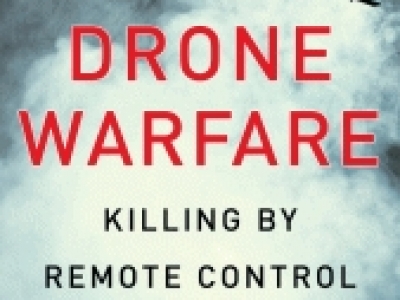Beyond videogames: lethal consequences of drone warfare
Empowering Weak & OppressedYasmeen A Khan
Shawwal 24, 1434 2013-09-01
Special Reports
by Yasmeen A Khan (Special Reports, Crescent International Vol. 42, No. 7, Shawwal, 1434)

Yasmeen A Khan reviews Medea Benjamin’s book: Drone warfare: Killing by remote control and offers a chilling account of how drones have destroyed so many innocent lives.
Yasmeen A. Khan reviews Drone Warfare: Killing By Remote Control by Medea Benjamin (OR Books: New York and London, 2012); 241 pages, $16.95.
As drones have become an inescapable feature of global war, they are generating a prolific literature on the full-spectrum perils — ethical, human, and geostrategic — of unmanned aerial warfare. Another valuable contribution to the field is a new book by Medea Benjamin, founder of feminist anti-war organization CODEPINK, which is titled Drone Warfare: Killing by Remote Control. Benjamin has meticulously researched her topic, as attested by the 334 footnotes and lengthy list of references, collecting the scattered white papers, human rights reports, and news articles into one comprehensive source.
The first three chapters of Drone Warfare demonstrate how drones have become integral to the US military-industrial complex — indeed, to a new century of warfare subscribed to by “great power” hopefuls like India or China, and aging powers desperate to hold onto their dominance. There is also some valuable history to the hyper-tech drone saga playing out in breathless media reports. While UAVs (unmanned aerial vehicles) have been tested since WWI, drones first played a dominant role in warfare when Israel used them in its 1982 war against Lebanon. Israeli spy aircraft innovation from the 1970s and 1980s was gradually incorporated by the Pentagon, who deployed drones against Iraq (when it invaded and occupied Kuwait) in what came be called the (Second) Gulf War.
Benjamin delves further into the Israeli-US nexus in drone research — she describes how the prototype of the Predator drone currently used by the US in Afghanistan and Pakistan was developed by an Israeli aviation engineer, Abraham Karem. Karem, flush with research and development funds from the Pentagon, built the Predator in his three-car garage in Southern California in the 1980s. Eventually, the technology was sold to General Atomics, who retained Karem as a consultant. It was during the Bosnian War when then-CIA director James Woolsey found himself dissatisfied by the aerial intel, turning to Karem and the Predator prototype to join the campaign to gain control of the battlefront.
The lingo of video-game simulated, robotic warfare began to seep into journalist speak in the Bosnia War, with talk of “laser-guided smart bombs” as opposed to the “dumb bombs” raining down death in the Gulf War. But it was with 9/11 and its inauguration of the War on Terror (WoT) that the drone industry truly began to explode. Congress authorized billions of dollars for the Pentagon to fight the WoT, and a significant portion of it was funneled out to defense contractors to churn out more and more advanced drone models. Benjamin writes that defense contractors could not produce drones fast enough.
“They [the Pentagon] snatched up every type of drone on the productive line and commissioned new ones. They bought the 38-inch long Raven that is launched by simply throwing it into the air; the 27-foot long Predator with its Hellfire missiles, and later the more powerful Reaper version; the 40-foot-long Global Hawk with sci-fi surveillance capabilities.” (p. 16). In fact, drones are poised to make manned fighter jets obsolete. Former Secretary of Defense Robert Gates announced in 2009 that the “F-35 that took decades to develop at a cost of more than $500 million each, would be the Pentagon’s last manned fighter aircraft” (p. 17).
Drone war is an inextricable part of the WoT, seeping into domestic surveillance within the United States under the aegis of the draconian Homeland Security department. Benjamin devotes time to look into how drone tech is being exported globally, illuminating the specter of robotic Armageddon where nations go to war, deploying drones for senseless, unrestrained killing. However, one deficiency in Drone Warfare is that it focuses on US drone use in Muslim majority countries. The lack of information on how drones are being used domestically as well as in foreign battlefronts prevents her from illustrating some valuable points about drone warfare. In effect, it shows how the nation state has become obsolete, a figment whose neutered laws offer no resistance to the US from its surveillance and killing of Muslims, progressives, and dissidents worldwide.
The later chapters of Drone Warfare look into the human casualties of drone warfare in the Muslim East, and Afghanistan-Pakistan. Benjamin strives to outline the ethical questions surrounding this form of remote control killing on both sides of the equation. She describes some of the scenes of carnage at drone strikes, looking at the ghastly margin of error in “precision” strikes that have destroyed the lives of teachers, children, journalists, taxi-drivers, wedding party guests, and other civilians. In addition, she outlines the cost on the other side of the equation. That is, the billions of dollars redirected from “healthcare, education and infrastructure,” not to mention the deadening of the human spirit that takes place when “cubicle warriors” rain down death with a playstation joystick.
Some of the most chilling sections of Drone Warfare are the glimpses into the faceless drone pilots manning the aerial robots — how their Dilbert-like daily routine is steeped in the normalization of remote-controlled death. Recognizing the pervasiveness of videogame culture, drone manufacturers have modeled the drone’s operating center on the playstation. Benjamin cites the example of retired Col. Chambliss, who could “remotely order a Predator drone to fire a Hellfire missile at a group of suspected Taliban… while a few hours later, making it in time to catch a re-run of Friends” (p. 83). She also culls articles from the New York Times and other periodicals, to describe the thousands of hours of live feed from drones flying in Af-Pak or Horn of Africa battlefronts, which is also known as “Death TV” in Langley, Virginia.
The new breed of desk chair pilot is one who belongs in the virtual world of gaming, unable to distinguish between reality and virtuality. A drone pilot in Qatar noted that “It’s like a video game. It can get a little bloodthirsty. But it’s f***ing cool.” As P.W. Singer noted in his book Wired for War, “…‘going to war’… [now simply means] a daily commute in your Toyota Camry to sit behind a computer screen and drag a mouse” (pp. 85–86). Medea Benjamin has made a well-researched and effective contribution to drone studies; she also makes sure to represent the feminist and progressive opposition to the dawning century of robotic warfare. Drone Warfare is part of a worthy collection to any home or institutional library.




